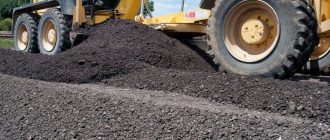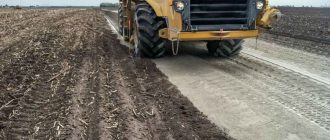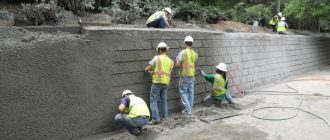
How Soil Stabilization Enhances Ground Support in Slope Stability
Stabilization plays a crucial role in ensuring the stability of slopes and preventing ground failures. Slope stability is a critical consideration in engineering and construction projects, as failures can lead to significant damage, loss of life, and increased costs. Soil stabilization is an effective technique that enhances the ground’s stability, providing a solid foundation for various structures.
The process of soil stabilization involves modifying the physical and chemical properties of the soil to increase its strength, durability, and load-bearing capacity. This can be achieved through various methods such as adding stabilizing agents, compacting the soil, or applying geosynthetic materials. By enhancing the soil’s properties, stabilization minimizes the potential for slope failures and ground movements.
Enhancing ground support through soil stabilization not only reduces the risk of slope instability but also enhances the overall safety and longevity of structures. It ensures that the soil can withstand the applied loads and environmental factors, such as rainfall and seismic activity. This, in turn, minimizes the need for frequent repair and maintenance, resulting in cost savings in the long run.
Soil stabilization enhances ground support and slope stability by:
- Improving soil compaction and preventing settlement
- Increasing the soil’s shear strength and resistance to erosion
- Reducing the amount of water infiltration and swell potential
- Controlling the soil’s plasticity, shrinkage, and swelling characteristics
In conclusion, soil stabilization is a vital technique in enhancing ground support and slope stability. It provides a solid foundation for structures, reducing the risk of slope failures and ground movements. By improving the soil’s properties, stabilization ensures the durability and longevity of constructions, resulting in cost savings and increased safety.
Importance of Ground Support in Slope Stability
Ground support plays a crucial role in ensuring the stability of slopes. Slopes are vulnerable to various factors that can induce soil movement and instability. When the stability of a slope is compromised, it can have severe consequences such as landslides, soil erosion, and damage to infrastructure.
Soil stabilization is a technique that enhances the strength and stability of soil in slopes. It involves the use of various methods to improve the engineering properties of soil, making it more resistant to slope failure. Ground support systems, such as retaining walls and soil nails, reinforce the soil and provide additional support against forces that could potentially cause slope instability.
Enhancing ground support in slope stability offers several advantages. Firstly, it increases the overall stability of the slope, reducing the risk of slope failure and associated hazards. It helps to prevent soil erosion, as the ground support systems hold the soil in place and prevent it from being washed away by water or other erosive agents.
In addition, ground support systems can also provide structural support to infrastructure built on or near slopes. They help to distribute loads evenly and reduce the pressure exerted on the soil, minimizing the chances of settlement or structural failure. This is particularly important in areas with high seismic activity, where slopes are susceptible to dynamic loads generated by earthquakes.
Furthermore, ground support systems can be designed to accommodate specific slope conditions and requirements. They can be tailored to address the unique geo-environmental factors and challenges associated with each slope, ensuring optimal stability and performance.
In conclusion, ground support plays a vital role in enhancing slope stability. By improving the strength and stability of soil through soil stabilization techniques and implementing ground support systems, the risks associated with slope failure can be significantly reduced. The use of proper ground support measures can prevent landslides, soil erosion, and damage to infrastructure, promoting safer and more secure slopes.
Understanding Soil Stabilization
Soil stabilization is a process used to improve the stability of the ground, especially on slopes. It helps enhance the strength and durability of soil, making it less prone to erosion and movement.
The stability of soil is crucial in various applications, including construction, mining, and road infrastructure. Unstable soil can lead to slope failures, landslides, and other hazardous consequences.
The process of soil stabilization involves improving the engineering properties of soil to make it more suitable for supporting structures and preventing soil erosion. It typically includes techniques such as compaction, chemical stabilization, and mechanical stabilization.
- Compaction: Compacting the soil increases its density and reduces void spaces, making it more stable and less susceptible to movement.
- Chemical stabilization: This technique involves adding chemicals to the soil to improve its engineering properties. Common additives include cement, lime, and fly ash, which help increase the soil’s strength and reduce its plasticity.
- Mechanical stabilization: Mechanical stabilization techniques involve reinforcing the soil using geosynthetics, such as geotextiles and geogrids. These materials provide additional strength and stability to the soil, enhancing its load-bearing capacity.
Soil stabilization plays a critical role in preventing slope instability and protecting the surrounding environment. It helps reduce the risk of landslides and erosion, ensuring the safety and longevity of infrastructure projects.
By understanding soil stabilization techniques and their benefits, engineers and geotechnical professionals can design and implement effective ground support measures to enhance slope stability and mitigate potential hazards.
Techniques for Enhancing Ground Support
Enhancing ground support is essential for stabilizing slopes and improving overall soil stabilization. By implementing various techniques, the stability of the slope can be significantly enhanced, providing a safer environment for construction and minimizing the risk of slope failures.
One common technique for enhancing ground support is through the use of soil stabilization methods. This involves treating the soil to improve its mechanical properties and increase its resistance to erosion and movement. Stabilization techniques can include the use of chemical additives, such as cement or lime, to improve the soil’s strength and stiffness.
Another technique is the implementation of ground improvement measures, such as the installation of ground anchors or piles. Ground anchors are tensioned cables that are drilled and grouted into the ground to provide stability. Piles, on the other hand, are long, slender structural elements that are driven into the ground to support the load of the slope.
Additionally, the use of geosynthetics is a common technique for enhancing ground support. Geosynthetics are synthetic materials that are used in construction to improve the soil’s properties and provide additional reinforcement. Examples of geosynthetics include geotextiles, geogrids, and geocells, which can be used for slope stabilization and erosion control.
| Soil Stabilization | Treating the soil to improve its mechanical properties and increase resistance to erosion and movement. |
| Ground Anchors | Tensioned cables drilled and grouted into the ground to provide stability. |
| Piles | Long, slender structural elements driven into the ground to support the load of the slope. |
| Geosynthetics | Synthetic materials used to improve soil properties and provide additional reinforcement. |
In conclusion, incorporating techniques such as soil stabilization, ground anchors, piles, and geosynthetics can significantly enhance ground support and improve slope stability. By implementing these methods, the risk of slope failures can be reduced, ensuring a safer and more stable construction environment.
Role of Geotextiles in Soil Stabilization
The use of geotextiles plays a crucial role in enhancing the stability of soil and supporting ground in slope stability. Geotextiles are permeable fabrics that are placed within or below soil to reinforce it and improve its engineering properties. These materials are made from synthetic fibers that are resistant to biological degradation and can withstand the stresses imposed by soil mechanics.
Geotextiles enhance slope stability by providing additional tensile strength to the soil. This reinforcement prevents soil mass movement and helps to maintain the integrity of the ground. By distributing load stresses more evenly, geotextiles can reduce the risk of slope failure and improve the overall stability of the soil structure.
One of the key advantages of using geotextiles in soil stabilization is the improvement it brings to the overall drainage system. Geotextiles allow water to flow through them while retaining soil particles, thus preventing the movement and washing away of soil. This enhanced drainage capability reduces the likelihood of the ground becoming saturated, which can lead to soil erosion and instability.
In addition, geotextiles can help to control soil erosion by protecting the surface of the soil from the erosive forces of wind and water. They can also be used to anchor vegetation and promote the growth of vegetation on slopes. This vegetation not only adds aesthetic value but also helps to stabilize the soil by acting as a natural reinforcement system.
Overall, the role of geotextiles in soil stabilization is essential in improving ground support and slope stability. By enhancing the strength and drainage capability of soil, geotextiles minimize the risks associated with slope instability and erosion. When properly installed and maintained, geotextiles can significantly enhance the performance and longevity of soil structures, making them an invaluable tool in soil stabilization.
Advantages of Using Geosynthetics
Geosynthetics are a type of material used in soil stabilization that offer numerous advantages for enhancing ground support and slope stability. These materials are typically made from synthetic fibers and polymers, and they can be used in a variety of applications to improve the performance and durability of soil.
One of the key advantages of using geosynthetics is their ability to increase the stability of slope surfaces. By reinforcing the soil and preventing the movement of particles, geosynthetics can help to prevent slope failure and landslides. This is particularly important in slope stability projects where the ground is prone to erosion or slippage.
In addition to improving stability, geosynthetics provide enhanced ground support. They can distribute loads more evenly across the soil, reducing the risk of localized failure. This is especially beneficial in areas with heavy foot or vehicular traffic, as it helps to prevent the formation of ruts, potholes, and other surface irregularities.
Another advantage of using geosynthetics is their ability to enhance the soil’s resistance to erosion. By acting as a barrier against water flow, geosynthetics can help to retain the soil particles and prevent them from being washed away. This is important for projects located near bodies of water or in areas with high rainfall, where erosion can be a significant problem.
Furthermore, geosynthetics offer the advantage of being lightweight and easy to install. They can be quickly and efficiently deployed to stabilize soil, saving both time and labor costs. This makes them a cost-effective solution for slope stability and soil stabilization projects.
| – Increased slope stability |
| – Enhanced ground support |
| – Improved resistance to erosion |
| – Lightweight and easy to install |
In conclusion, the use of geosynthetics in soil stabilization and slope stability projects offers numerous advantages. From enhancing ground support to improving resistance to erosion, these materials provide a cost-effective and efficient solution to enhance the performance and durability of the soil.
Implementation of Soil Stabilization Methods
Soil stabilization methods play a crucial role in enhancing ground support and slope stability. These methods involve various techniques and materials to improve the engineering properties of soil and increase its ability to withstand loading and erosion.
One commonly used soil stabilization method is the addition of cementitious materials, such as cement or lime, to the soil. This process, known as chemical stabilization, involves mixing the cementitious material with the soil to create a stabilized mixture. The cementitious material reacts with the soil particles, forming chemical bonds that increase the strength and cohesion of the soil. This method is effective in stabilizing loose or weak soils and can significantly enhance the stability of slopes.
Another method of soil stabilization is the use of geosynthetics, which are synthetic materials specifically designed for soil reinforcement. Geosynthetics, such as geotextiles or geogrids, are placed within the soil to provide additional support and increase its load-bearing capacity. These materials function by distributing the applied loads over a wider area, reducing stress concentrations, and preventing soil movement. Geosynthetics are commonly used in slope stabilization projects to reinforce the soil and prevent slope failure.
Furthermore, soil stabilization methods can also involve the use of chemical additives, such as stabilizing agents or polymers. These additives are mixed with the soil to improve its mechanical properties, such as plasticity, strength, and resistance to erosion. Stabilizing agents can chemically bind with the soil particles, while polymers can improve the soil’s ability to retain water and resist deformation. These additives are beneficial in stabilizing expansive or highly erodible soils, thereby enhancing the overall ground support and slope stability.
In conclusion, the implementation of soil stabilization methods enhances ground support and slope stability by improving the engineering properties of the soil. Techniques such as chemical stabilization, the use of geosynthetics, and the addition of chemical additives significantly enhance the soil’s ability to withstand loading, resist erosion, and prevent slope failures. These methods are essential in slope stability projects and contribute to the safety and longevity of engineering structures.
Monitoring and Maintenance of Stabilized Slopes
Stability is a crucial factor in any slope construction project. The support and longevity of a slope greatly depend on the effectiveness of soil stabilization techniques. Stabilization enhances the overall slope stability by improving soil characteristics.
After implementing soil stabilization methods, monitoring is crucial to ensure that the stability is maintained over time. Regular inspection and maintenance activities should be carried out to identify any potential issues and address them promptly.
Monitoring of stabilized slopes involves visual inspections and the use of geotechnical instrumentation. Visual inspections consist of observing the slope for signs of distress such as cracks, erosion, or bulging. Any observed changes should be investigated further to prevent slope failure.
In addition to visual inspections, geotechnical instrumentation provides valuable data for assessing slope stability. Instruments such as inclinometers, piezometers, and settlement plates are used to measure slope movement, groundwater pressure, and settlement, respectively.
Maintenance of stabilized slopes is necessary to ensure the long-term stability and functionality of the slope. This includes activities such as vegetation management, erosion control, and drainage maintenance. Vegetation plays a crucial role in preventing erosion and improving soil cohesion, so regular monitoring and maintenance of vegetation cover is essential. Erosion control measures such as geotextiles or retaining walls should be inspected and repaired if necessary.
Drainage is another critical aspect of slope maintenance. Proper drainage prevents the accumulation of excess water, which can weaken the stabilized soil and compromise slope stability. Regular inspection and cleaning of drainage systems are necessary to ensure their effectiveness.
In conclusion, monitoring and maintenance are vital for ensuring the stability and longevity of stabilized slopes. Regular inspections, both visual and using geotechnical instrumentation, help identify any potential issues before they escalate. Timely maintenance activities, such as vegetation management and drainage maintenance, are necessary to preserve the effectiveness of stabilization techniques and enhance slope stability.
Case Studies of Successful Soil Stabilization Projects
In the field of slope stability and ground support, soil stabilization plays a crucial role in enhancing the strength and durability of the soil. Through various techniques and materials, soil stabilization aims to improve the load-bearing capacity of the ground and prevent soil erosion and settlement.
Several case studies have demonstrated the positive effects of soil stabilization in enhancing ground support and stability. One such project was carried out in a hilly area prone to landslides. By implementing soil stabilization techniques, including the use of geosynthetics and cementitious materials, the ground support was significantly improved. The stabilized soil prevented any further movement and provided a safe environment for construction work.
Another successful case study involved a railway construction project in a region with weak soil conditions. Through the application of soil stabilization methods, such as the inclusion of stabilizing agents and geosynthetic reinforcement, the ground was strengthened to support the heavy loads of the trains. This ensured the long-term stability of the railway infrastructure and minimized the risk of soil failure.
In a coastal area with sandy soil, a case study demonstrated how soil stabilization techniques can effectively mitigate the threat of erosion and maintain the stability of the ground. By using erosion control materials, such as vegetation and geotextiles, the sandy soil was stabilized and prevented from being washed away by the tides and waves. This enhanced the ground support and protected the area from the damaging effects of erosion.
These case studies highlight the significant benefits of soil stabilization in enhancing ground support and stability. By applying the appropriate techniques and materials, soil stabilization can effectively improve the load-bearing capacity of the soil, prevent erosion and settlement, and ensure the long-term stability of the ground. It plays a vital role in slope stability and ground support, providing a safe and reliable environment for various construction and infrastructure projects.
Benefits of Soil Stabilization in Construction
Soil stabilization plays a crucial role in enhancing the support and stability of slopes and ground in construction projects. By implementing soil stabilization techniques, the overall performance and longevity of the structures are significantly improved.
Here are some key benefits of soil stabilization in construction:
| 1 | Enhancing Slope Stability: | One of the primary advantages of soil stabilization is its ability to enhance slope stability. By treating the soil with stabilizing agents, such as cement, lime, or fly ash, the soil’s cohesion and bearing capacity are improved, reducing the risk of slope failure and landslides. |
| 2 | Improved Ground Support: | Soil stabilization measures enhance the ground support by increasing the soil’s load-bearing capacity. This is especially crucial in construction projects where heavy structures, such as buildings or bridges, are built on weak or unstable soil. Stabilizing the soil ensures that it can adequately support the weight and withstand any potential settlement or movement. |
| 3 | Long-lasting Solution: | Soil stabilization provides a long-lasting solution for improving slope and ground stability. The treated soil becomes more resistant to erosion, weathering, and other environmental factors, ensuring the longevity and durability of the constructed structures. |
| 4 | Cost-effective: | Implementing soil stabilization techniques can be a cost-effective solution in construction projects. By stabilizing the soil, the need for extensive excavation, soil replacement, or additional materials can be significantly reduced, resulting in cost savings. |
| 5 | Environmentally Friendly: | Soil stabilization is an environmentally friendly approach compared to traditional soil improvement methods. By utilizing stabilizing agents, the need for excessive use of natural resources, such as gravel or other construction materials, is minimized. Additionally, stabilizing the soil can also help in reducing the release of harmful pollutants into the environment. |
Overall, soil stabilization techniques significantly enhance the support and stability of slopes and ground in construction projects. These methods provide a cost-effective, long-lasting, and environmentally friendly solution, ensuring the safety and durability of the constructed structures.
Considerations for Selecting Soil Stabilization Techniques
When it comes to enhancing ground support in slope stability, selecting the right soil stabilization technique plays a crucial role. Various factors need to be considered before choosing the most suitable technique for a particular project.
1. Soil Type: The type of soil being stabilized is an important consideration. Different stabilization techniques are effective for different soil types. For example, cement stabilization is often used for clay soils, while chemical stabilization can be more appropriate for sandy soils.
2. Slope Steepness: The steepness of the slope also influences the choice of soil stabilization technique. Methods such as soil nailing or ground anchors are often used for steeper slopes, while techniques like geogrids or geotextiles may be more suitable for gentler slopes.
3. Budget: The available budget for the project is another factor to consider. Some soil stabilization techniques may be more costly than others. It is important to evaluate cost-effectiveness and determine the most efficient technique that fits within the budget constraints.
4. Environmental Impact: The environmental impact of the soil stabilization technique should also be taken into account. Some methods may be more sustainable and eco-friendly, while others may have a larger carbon footprint or produce more waste materials.
5. Project Duration: The duration of the project is another aspect to consider. Some soil stabilization techniques require longer curing times or multiple stages, which can prolong the project timeline. It is essential to assess the time constraints and select a technique that can meet the project’s schedule.
6. Expertise and Equipment: The availability of expertise and equipment is an important consideration. Certain stabilization techniques may require specialized knowledge or equipment that may not be readily available. It is crucial to determine if the necessary resources can be obtained for the selected technique.
By considering these factors, engineers and project managers can make informed decisions when selecting soil stabilization techniques for enhancing ground support in slope stability. It is important to evaluate the specific needs of each project and choose the technique that best addresses those needs to ensure a successful and stable outcome.
Frequently asked questions:
What is soil stabilization?
Soil stabilization is a process in which soil is treated to improve its strength and durability. This is done by adding materials that enhance the soil’s properties and make it more suitable for construction or other applications.
Why is soil stabilization important in slope stability?
Soil stabilization is important in slope stability because it helps to prevent slope failures and landslides. By improving the strength and stability of the soil, it reduces the risk of slope movements and increases the safety of the slope and the surrounding area.
What materials can be used for soil stabilization?
Various materials can be used for soil stabilization, depending on the specific requirements and conditions. Common materials include cement, lime, fly ash, and chemical additives. These materials react with the soil to improve its properties and enhance its stability.
How does soil stabilization enhance ground support?
Soil stabilization enhances ground support by strengthening the soil and reducing its susceptibility to movement. This improves the stability of the ground and provides better support for structures or other elements that rely on the soil for stability.
What are the benefits of soil stabilization?
Soil stabilization offers several benefits, including improved slope stability, increased load-bearing capacity, reduced settlement, and enhanced durability of the soil. It also allows for cost-effective construction and reduces the need for extensive excavation or replacement of soil.
What is soil stabilization and why is it important?
Soil stabilization is the process of improving the engineering properties of soil to enhance its stability and strength. It is important because it helps prevent slope failure and erosion, ensuring the safety and longevity of structures built on or near slopes.
What are some common methods of soil stabilization?
There are several common methods of soil stabilization, including the use of cement, lime, or fly ash to chemically alter the soil properties, the installation of geosynthetics such as geotextiles or geogrids to provide additional reinforcement, and the application of surface protections like erosion control blankets or hydroseeding.






